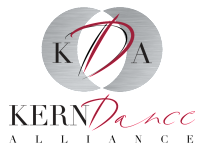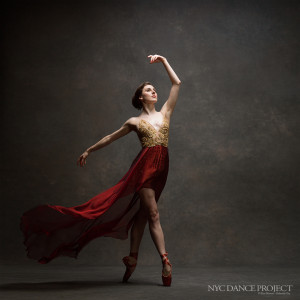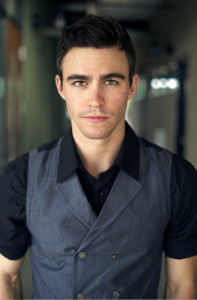NEWSLETTER — September 2015
- FEATURE STORY
- FUEL FOR THE JOURNEY
- PERFORMANCE PYSCHOLOGY
- THE BUSINESS OF DANCE
- DANCE SCIENCE CENTER
- KDA 'HOW TO'
Whether performing on the stages of New York City or in front of a camera in Hollywood, many dancers who made their start in the small studios of Kern County have gone on to find great success as professional dancers and performers across the United States. KDA got in touch with Kern County dance alumni Tiler Peck, Sasha Mallory, Mason Trueblood and Geoffrey Kropp, to ask about their biggest challenges, their memorable moments and that all important question, ‘What’s the last thing you ate?’
How old were you when you know you wanted to make dance your profession?
Sasha Mallory: I think I was around 10 years old when I discovered that I wanted to make dance my profession. When I was younger I idolized professional ballet dancers and dreamt of becoming one.
Mason Trueblood: Believe it or not, I don’t think I knew I wanted to make dance my profession until I was already dancing professionally. Dance has always been a huge part of my life – a weekly hobby that became my life’s routine – it really permeates all that I do, but I’ve always seen it as a means to the end and not the end itself. I want to be an artist, but not exclusively in one medium. I’ve set out to inspire, to entertain, and to provoke conversation. To wrestle with what it means to be human and share that experience with others; dance has always been a fantastic vehicle for that kind of communication.
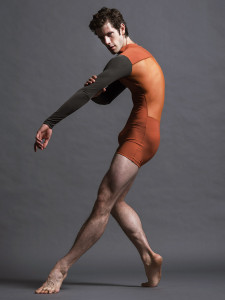
Geoffrey Kropp has danced with Kansas City Ballet for ten years. This image of him features Eleve dancewear, photo by Kenny Johnson.
Geoffrey Kropp: As soon as I knew that ballet could be a job, I knew that was what I wanted to do. When I was 12, I spent the summer training at the San Francisco Ballet School’s Summer Intensive, and that was when I saw that you could be a dancer as a profession. At 17 years old I really committed to making a job out of my passion. I moved to Philadelphia to study at the Rock School for Dance Education and then to Seattle to train with Pacific Northwest Ballet.
What is the greatest challenge you’ve faced in your career? How did you overcome it?
Tiler Peck: I suffered a stress fracture when I was 18 years old and had to be out for a total of six months. It took three months of complete rest to let it heal and three months of intense physical therapy before I was on the stage again. Injuries are sometimes a blessing in disguise because you become more aware of your body and also normally come back stronger than before.
Sasha Mallory: One of the greatest challenges I’ve had to overcome was being a part of the TV broadcast of So You Think You Can Dance. Being on that show was extremely demanding on the body and spirit. Although it was very intense, I learned that my body and spirit could take a lot more hardship that I ever knew. I tried to stay focused on whatever was the task at hand. I went through the whole process step by step focusing on the details of each movement I had to make.
What is your greatest physical strength as a dancer? What is your greatest physical weakness and how do you overcome it?
Mason Trueblood: My greatest physical strength as a dancer is my ability to tap dance, which I attribute to both rhythm and a precision and quickness of my feet. My greatest weakness as a dancer is definitely my flexibility. I’ve worked hard for to overcome this “weakness” by stretching daily and often, which helped, but never enough. I decided the best way to overcome this is to learn how my body works and embrace the facilities that I have. This freed me up to just enjoy the uniqueness of my own physicality and my own movement, not judge it for its “imperfection” or “substandard performance” in comparison to others.
Geoffrey Kropp: I think my height is both a strength and a weakness for me. At 6’4”, I’m pretty tall for a dancer. For partnering, it is great. When a ballerina goes up en pointe, she gets six inches taller, but that isn’t a problem for me. It also helps me stand out. But at the same time, there is a lot of me to control and moving the same speed as a dancer who is 5’7″ can be hard. And, because my height makes me stand out, if I’m off with something, everyone can see it.
If you could offer just one piece of advice to the next generation of dancers, a younger version of yourself, what would that be?
Tiler Peck: Try not to measure your worth and success by comparing yourself to others. Each individual has his or her own gifts and should only focus on his or her own path and career.

Appearing on “So You Think You Can Dance” was physically and emotionally grueling, but it showed Sasha she was capable of much more than she realized.
Sasha Mallory: Don’t ever hesitate when you have an idea that you want to make into reality. Working hard always pays off. Maintain the quality and integrity of your art and never doubt it if you inspire yourself and others. Keep on creating.
Mason Trueblood: Fully enjoy the moment and the people within it. This isn’t profound, but we’re often distracted from truly living in the moment and investing in the people around us. My advice is to fight distraction and seize the moment with fervor – laugh harder, smile bigger, hug harder, work diligently, seek fun, and don’t take for granted the people around you. It’s amazing how this changes your dancing.
Geoffrey Kropp: Dance for yourself and focus on your own path. As hard as it is, try not to spend energy comparing yourself to everyone else. Don’t worry that this dancer got a better part or got moved up before you. Don’t worry that that dancer did more turns or jumped higher than you. Dance is such a competitive field (and such a short career), it’s not worth wasting energy. Pushing yourself is good (and necessary), and some competition is important, but always try to dance for yourself. Work hard, focus on your technique, and you will improve.
What is your pre-performance ritual?
Sasha Mallory: I like to meditate for a moment to center myself in my surroundings. I make sure all of my muscles are warmed up and ready to go. I double and triple check all of my costumes if I have costume changes … just little things like that.
Geoffrey Kropp: I am very particular about what I eat before a show-scrambled eggs on toast with avocado. If it’s an evening performance, I try to take a quick nap beforehand. And right before the show, my dressing-room-mate and I often have a little dance party while we get ready, often to bad 90’s music.
What would you say to someone who thinks dance isn’t a ‘real career’?
Sasha Mallory: I would probably give them a hug because they just don’t know any better. That would be like saying art is irrelevant.
Mason Trueblood: I would ask this person to define a “real career,” because we obviously have two very different definitions. Pouring yourself into a vocation that requires logic, high levels of physical exertion, and passion coupled with discipline and a strong-willed determination is a worthy venture by any standard. Especially when this work then inspires and moves others to be active and share their voice with the world. Dance is a real career – the only way around that truth would be ignorance.
Geoffrey Kropp: I get that a lot (“But what’s your day job?” they ask), but once I tell people my typical work week, they start to understand. With Kansas City Ballet, we work Tuesday through Saturday, 9:15am to 6:00pm. It’s a real job.
Now for the hard-hitting questions. What’s the last thing you ate?
Tiler Peck: a chocolate chip cookie
Sasha Mallory: kale chips
Mason Trueblood: a delicious homemade tuna-melt with chips and hummus
Geoffrey Kropp: a bowl of cereal
Our Contributors:
Tiler Peck is in her fifth year as Principal Dancer with New York City Ballet. She had the honor of performing for President Obama at the 2012 Kennedy Center Honors and recently played the title role in Susan Stroman’s newest musical, “Little Dancer”, at the Kennedy Center. Tiler was seen on Broadway as Ivy Smith in “On The Town” and in 2013, she was named Forbes 30 under 30 in Hollywood Entertainment. Ms. Peck is also designer of Tiler Peck Designs.
Sasha Mallory was the runner-up on Season 8 of “So You Think You Can Dance”. She also appeared in the movie Crave and danced in Madonna: The MDNA Tour. She is currently preparing to perform her second international tour with Madonna.
Mason Trueblood recently earned a Bachelor of Fine Arts in Dance Performance and a Bachelor of Art in Film and Media Studies from UC Irvine. He lives in Los Angeles where he has performed on the television show “Glee” as well as several movies.
Geoffrey Kropp has danced with the Kansas City Ballet for ten years. He has also performed with the National Choreographer’s Initiative, Kansas City Dance Festival, ARC Dance, Owen/Cox Dance Group and UMKC’s Conservatory of Music and Dance.
By Marcie Hronis
To perform their best, dancers need to be well-fueled for classes, rehearsals, and performances. Protein is needed to repair the breakdown of muscle fibers that are stressed by constant use. It is also used as an auxiliary fuel, and is important for synthesizing the many enzymes necessary for metabolism. Protein is made of amino acids, some of which are termed “essential” because we cannot produce them and need to get them from our diet.
Should you eat the protein every day? The body is better able to utilize protein when it is eaten in moderate regular doses throughout the day and also post workout. Try to divide up total daily dietary protein into regular meals. For example, a professional level dancer would need to eat 10-20 grams of protein with a balanced meal within 1 hour post-exercise. However, some studies show that the body’s muscle building/repair response will still occur if the protein is eaten within 24 hours of exercise.
Quinoa Tabbouleh
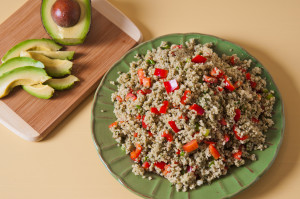
Quinoa is a gluten-free grain crop that is grown for its edible seeds. It is pronounced KEEN-wah. 1 cup of cooked quinoa contains 8 grams of protein, 5 grams of fiber and very little fat!
Tabbouleh:
1 C
1
1/4 – 1/2 C
1/2 C loosely packed
1 – 2 C
1/2 C
Grape Tomatoes – halved or quartered
Hot House Cucumber – cubed small
Kalamata Olives pitted – halved or quartered
Mint fresh – chopped
Parsley curly – finely chopped
Green Onions – chopped small (optional)
Dressing:
2
2 – 6 cloves
To Taste
To Taste
Lemons small – juiced
Garlic – finely chopped or pressed
Salt
Italian Seasoning (optional for dressing)
DIRECTIONS:
- Place quinoa in a colander and rinse several times rubbing the grains together to remove the bitter outer layer.
- Place 2 cups of water and quinoa into a saucepan and bring to a boil. Reduce heat to a simmer and cover. Cook for 10 to 15 minutes or until water has been absorbed. If quinoa is cooked but there is still liquid in the pot, then drain with a fine mesh strainer.
- In a bowl put tomatoes, cucumber, parsley, onions and mint. Add lemon juice and olive oil. Mix well.
- Stir in cooked cooled quinoa and salt. Mix well.
- Let tabbouleh sit in the refrigerator for a day to blend flavors.
- Tabbouleh is usually served at room temperature so remove from the refrigerator 30 to 60 minutes before serving.
- Assemble dressing: Combine olive oil, lemons, garlic, salt and Italian seasoning in a jar. Put on jar lid and shake well.
Serves: 4-8 side dishes
by Amy Adams
As a performer I have always been so intrigued by the psychological perspective of all great performers; world class, singers, dancers, and athletes. Is there a possible common thread in all of them and how does the psychology of such great performers work? Throughout our KDA newsletter journey you will be invited into the minds of many successful individuals who have found a way to reach their personal goals and world celebrated achievements. They will share stories of insight and heart of their great challenges and even greater victories.
Kristina Lum Underwood is our first featured performer.
During Kristina Lum Underwood’s career as a competitive synchronized swimmer she amassed many honors. She was the four time National Team and Duet Champion and two time National Solo Silver Medalist, she was US Synchronized Swimming ‘Athlete of the Year’ in 2000, and that same year represented American in synchronized swimming in the Olympic Games held in Sydney, Australia. She had gone on to appear in commercials and music videos and in 2006 joined the cast of Le Rêve, a regular show at the Wynn Hotel in Las Vegas. She was married with a small child and another one on the way. By all accounts she was a happily retired professional athlete.
One phone call in November of 2014 changed everything. Her former synchronized swimming partner, Bill May, was on the phone with news they had been waiting for 17 years- mixed duet was added as a category at the World Aquatic Championships to be held in Kazan, Russia in July 2015.
Bill and Kristina were some of the first competitors to work in the mixed duet format. “In 1998, my coach paired me with a male synchronized swimmer that had joined our club named Bill May. She wanted to create a mixed duet and do it in the style of ice dancing, really playing off the gender differences. This was something that the world had not really seen at an elite level,” Kristina explained. “Over the course of our careers, we won 4 national titles and won international titles at the French Open, Swiss Open, German Open and Rome Open and the silver medal at the Goodwill Games. Men were not allowed to compete at Worlds or the Olympics and this was something that we were trying to push for.” In 2003 they agreed that it was time to let go of their dream of competing in the World Championships as a mixed duet, and move forward with their careers. To hear the news that the category was added was truly a dream come true, there was only one problem.
Kristina was eight months pregnant with her second child who was due in January. Accounting for post-partum recovery, she would only have four months to prepare for the competition, a situation that was “unheard of”. After some soul searching and long talks with her family, she decided to go for it.
Once her daughter was born and her doctor cleared her for training, she was confronted by the reality of her circumstances “I am mom, a wife, a daughter, a sister, a friend, a performer/employee, a coworker, a teammate/duet partner. It got tricky prioritizing everything because they were equally important, since I could not do one without the other. I needed to be healthy for work because if I missed work, I couldn’t practice. I needed to be great for practice and keep pushing myself to my max, but still be able to perform at work and perform well, since that is my livelihood and is something that I would continue to do after this was all over.”
“I constantly had guilt, but mostly in the beginning. The worst day for me was one of the first times the kids came to the pool. My coach was in town from California and we weren’t having a great practice. My son had been watching our practice, I got out to feed my daughter, who I was still nursing, and he sat beside me. When it was time for me to get back in to the pool, he grabbed on to my leg and said “No pool mommy! No pool”!!! At the time, he didn’t speak much, so this was just heartbreaking. It was a constant struggle to not feel like I had abandoned my family to do something for myself.”
Knowing the intensity of her schedule was temporary, Kristina replaced her guilt with a sense of complete focus. “When we started out, I had a hard time focusing on one thing because I would be thinking about all of the other things going on in my day. My friend who is a sports psychologist told me to pick a key word to say to myself to snap me back into what I was doing. I would also have conversations with Amy Adams and she gave me great advice which was to be 100% in the moment, whatever it may be, because you can’t go back to redo it. No regrets. I also did a lot of visualizing. This was something I always did before when I was competing. Whenever I was driving, since that was usually my only free time to myself, I would play our competition music over and over again and visualize swimming perfectly. I did this whenever we would make changes to our routine as well, since I always had so many things to think about. If I made a mistake I would just keep doing it again until it was mistake free. I also visualized without music before I fell asleep. I would try to envision the competition pool and all of the surroundings with a perfect swim, which really helped me.”
On July 30, 2015, with her family watching from the stands, Bill May and Kristina Lum Underwood won the Silver Medal in the mixed duet free final at the FINA World Championships in Kazan, Russia. “This was such a special and incredible moment in the history of Synchronized swimming,” Kristina said. “I am so fortunate to be able to be a part of it.” The story of her relentlessness is so admirable with what she was physically able to achieve in what others perceived to be impossible.
Timing was everything, and her time is now.
by Andrea Hansen, M.F.A.
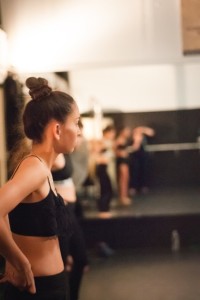
How will you stand out at auditions? Taking your dance resume seriously is the first step in showing that you are a professional.
The Dance Resume… a one-page snapshot of your dedication to the art of dance. While most resumes detail a majority of the same information, not all dance resumes are created equal. A dancer must consider the type of employment he/she is seeking and then craft his/her resume to meet the requirements of the job. For instance, a dancer applying for a specific casting role may list a different skill set than the dancer applying for a teaching position. The key to all resume writing is that you list the MOST IMPORTANT information pertinent to the desired job. Thoroughly research your prospective job and craft your resume to be the greatest representation of YOU.
High profile auditions can bring in up to 2000 dancers for 1 or 2 positions- your resume could potentially be the determining factor between you and the dancer to your right. When pencil meets the paper (or your finger meets the key), enlist the “3 P’s of Resume Writing: Proficient + Professional + Pithy.”
Proficient– Writing with proficiency is key. The abilities you list within your dance resume must speak specifically to the job requirements. If the job description details tap as a requirement, highlight your tap experience.
Professional- Much of the dance industry is under pressure to produce performances in a short amount of time, therefore employers are interested in working with dancers who are punctual, receptive to directions and able to be an asset to the company as a whole. Often the first question asked to most references on a resume is to describe the dancer’s professionalism.
Pithy- Keep your dance resume short and to the point. Instead of lengthy sentences or drawn out explanations, use bullet points and lists. An employer should be able to take a bird’s eye view of a resume and quickly know almost everything about your candidacy.
The dance resume can look very different depending upon the job description, however; the key components below can help you shine above the rest.
Contact Information-
List your name, address, phone number, and email address. If the job requires that you list your height, weight, eye and hair color- you may list that information here too.
Education-
List your formal education: High School, College, Post College, and Certification
Training-
List all formal dance study, master classes, workshops, and summer intensives. If you have trained with famous teachers, list their names too.
Professional Experience-
If you have professional experience in the realm of performance, teaching, or choreography list your previous employers and the dates in which you worked for these organizations.
Scholarship-
Have you been recognized for awards, scholarships, or grants? Always list your achievements and success.
Reference-
Choose 3 references- (ask permission first) and list their contact information. If your reference falls short in describing your reliability, then this may cause you your paycheck. First, verify with your references that you have their permission to list their contact information. Next, always inform your references that you have submitted their name for a potential job. The more prepared your references are to speak on your behalf the higher the probability you will win the job.
Finally, there a number of ways you can really “jazz up” your dance resume… here are a few ideas:
- Always use high quality paper when printing your resume.
- Print your resume on the backside of your 8X10 headshot.
- Print your resume on the backside of an 8×10 collage of your dance images showing versatility in your training.
- Print your resume on paper with a slight hint of color- try baby pink for a ballet audition.
- Attach a cover letter to your resume expressing your interest in the job and list a few more details about yourself that you have not listed on your resume.
Above all, stay positive and do not tell yourself no until someone else tells you no. Stay knowledgeable about employment opportunities and eventually the right position will find you!
By Katie Grimm, OTD, OTR/L
Dancing certainly brings joy and physical health, but did you know that it also positively impacts your brain function? Our nervous systems are wired by nerve cells called neurons that send messages to each other when the brain or a sensation tells them what to do. In other words, the neurons get stimulated. For example, if a ball is being thrown at you, the brain stimulates the motor neurons that fire off messages to our muscles to move out of the way so you do not get hit. When neurons talk to each other to send these messages, it is called a synapse. Neuron synapses are how we function every day.
When we learn something new whether it is an instrument, a new language, subject in school, vocational skill, or learning to dance, our brain forms new synapses – new neuron connections for messages to be sent within the nervous system. With these new connections, the brain can reorganize itself and change the way we process information. Some people struggle with the learning process and get overwhelmed with the feeling of “this is hard!” or even say, “my brain is going to explode!” However, with repetition of the dance steps those neuron connections get stronger and more efficient, taking up less space and effort in the brain. Essentially, the dance that was once hard becomes much easier. Whether it is your first class or you have been dancing for years, there are always new steps and routines being taught as well as learning to coordinate those steps with music.
Dancing taps in to many areas of the brain: the motor cortex for movement, the sensory and visual systems for processing sound and space as we move through the environment, the cerebellum for postural control and coordination, the basal ganglia for proprioception and sequencing of movements, and the frontal lobe for executive function as we think about the steps and put it all together. Meanwhile, the physical demands of dance keep your heart pumping to send oxygenated blood to the brain which is an added bonus.
It is healthy and essential for the brain to be challenged and to learn across the lifespan for better efficiency and function. Our brains are created for this! The “use it or lose it” principle remains true to keep an active and healthy brain. Dancing and other forms of new activity can help accomplish this. So get up, start dancing, utilize those neurons and have fun while exercising your brain!
Reference:
Lundy-Ekman, L. (2007). Neuroscience: Fundamentals for Rehabilitation (Third Edition). St. Louis, Missouri: Saunders Elsevier
Whether you are a dancer, studio owner or arts connoisseur, KDA is here for you.
- HOW TO GET A SCHOLARSHIP: If you’re interested in receiving a scholarship for your school, a workshop or even a summer intensive programs, KDA can help. We offer scholarships up to $500 – apply directly on our website – click here!
- HOW TO GET EVENTS POSTED: Studios, organizations and students are all able to have any and all events added to the KDA calendar! All you need to do is email fara@kerndance.org about your event, include all details and any image you’d prefer and it will be posted on the KDA calendar. FYI: in the near future, you will be able to post events yourself directly to KDA’s event page
- HOW TO FIND OR POST A JOB: On KDA’s site we have a job board that lists casting, employment and internship opportunities! To have something added to the job board, please email info@kerndance.org.
- HOW TO BECOME A MEMBER: Want to receive membership perks like tickets to great events? Want to be able to receive a scholarship? Want to collaborate and be involved with events that help arts and dance in our community? Want to be able to access all Kern County dance events in one place? It’s just $25/yr for individuals, $50/yr for organizations and $100/yr for venues. Become a member!
- HOW TO DONATE: Want to help KDA programming like the dance education and outreach program at The Fox Theater this fall? In November, KDA will host performance and dance classes for underprivileged children in partnership with Garden Pathways, The Boys and Girls Club and Bakersfield Homeless Center. Donate here or email us if you’d like to personally get involved!
- HOW TO SHARE WHAT KDA IS DOING: KDA would love you to share what we are doing! Follow us and share what’s going on – Twitter, Facebook, Instagram, and of course email links to our website or newsletter.
- HOW CAN KDA HELP YOU? If you want to collaborate, we have community connections and would be happy to help. Just shoot us a note and let us know what you as an individual or your organization needs help with, we will see what we can do!
